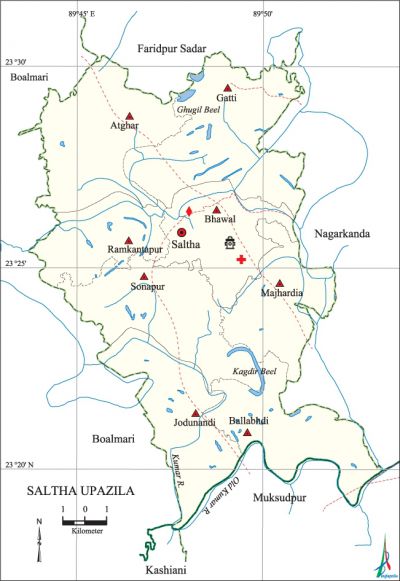Saltha Upazila
Saltha Upazila (faridpur district) area 182.96' sq km, located in between 23°18' and 23°30' north latitudes and in between 89°43' and 89°53' east longitudes. It is bounded by faridpur sadar upazila on the north, muksudpur and kashiani upazilas on the south, nagarkanda upazila on the east and boalmari upazila on the west.
Population Total 145710; male 74224, female 71486; Muslim 135224, Hindu 10471 and others 15.
Water bodies Main rivers: kumar and Old Kumar; Ghugil Beel and Kagdir Beel are notable.
Administration Saltha Upazila was formed in 2006 and its administrative activities start in 2008.
| Upazila | ||||||||
| Municipality | Union | Mouza | Village | Population | Density (per sq km) | Literacy rate (%) | ||
| Urban | Rural | Urban | Rural | |||||
|
- |
8 |
99 |
161 |
- |
145710 |
796 |
- |
31.16 |
| Union | ||||
| Name of union and GO code | Area (acre) | Population | Literacy rate (%) | |
| Male | Female | |||
|
Atghar 10 |
7020 |
10280 |
9777 |
26.92 |
|
Gatti 39 |
8499 |
14108 |
13203 |
35.58 |
|
Ballabhdi 11 |
5211 |
8663 |
8540 |
33.45 |
|
Bhawal 16 |
4661 |
9714 |
9493 |
31.90 |
|
Majhardia 61 |
4451 |
8223 |
7747 |
27.50 |
|
Jadunandi 44 |
5421 |
6997 |
6866 |
35.31 |
|
Ramkantapur 78 |
4106 |
7457 |
7353 |
28.90 |
|
Sonapur 89 |
6372 |
8782 |
8507 |
29.76 |
Source Bangladesh Population Census 2001, Bangladesh Bureau of Statistics.

Religious institutions Mosque 180, temple 15.
Literacy rate and educational institutions Average literacy 31.16%; Male 34.60%, female 27.62%. Educational institutions: college 2, secondary school 13, primary school 55, madrasa 5. Noted educational institutions: Saltha College, Saltha High School.
Cultural organisations Library 2, theatre group 3, playground 10.
Main sources of income Agriculture 82.34%, non-agricultural labourer 1.73%, industry 0.49%, commerce 6.12%, transport and communication 1.62%, service 3.19%, construction 0.88%, religious service' 0.23%, rent and remittance 0.17% and others 3.23%.
Ownership of agricultural land Landowner 70.54%, landless 29.46%.
Main crops Paddy, jute, wheat, potato, onion, chilli, vegetables.
Extinct or nearly extinct crops Linseed, kaun, arahar.
Main fruits Mango, jackfruit, litchi, black berry, shaddock, coconut, papaya, banana, guava.
Fisheries, dairies and poultries Dairy 70, poultry 50.
Communication facilities Pucca road 75.11 km, semi-pucca road 15 km, mud road 200 km; waterways 5 nautical miles.
Extinct or nearly extinct traditional transport Palanquin and bullock cart.
Noted manufactories Rice mill, welding factory.
Cottage industries Blacksmith, potteries, handicraft, bamboo and cane work.
Hats, bazars and fairs Hats and bazars are 25; most noted of which are Saltha Hat, Bhawal Bazar, Ramkantapur Bazar, Majhardia Bazar, Sonapur Bazar, Jadunandi Bazar, Atghar Bazar, Gatti Bazar, Bardia Bazar, Gourdia Bazar, Boalia Bazar, Nakulhati Bazar, Joykali Bazar.
Main exports Paddy, onion, chilli, vegetables.
Access to electricity All the unions of the upazila are under rural electrification net-work. However 12.33% of the dwelling households have access to electricity.
Sources of drinking water Tube-well 81.99%, tap 10.45%, pond 0.81% and others 6.75%.
Sanitation 33.81% dwelling households of the upazila use sanitary latrines and 55.24% of dwelling households use non-sanitary latrines; 10.95% of households do not have latrine facilities.
Health centres 'Family welfare centre 2, clinic 10.
NGO activities Operationally important NGOs are brac, asa. [Rajib Mondal]
References Bangladesh Population Census 2001, Bangladesh Bureau of Statistics; Field Report of Saltha Upazila 2007.'
